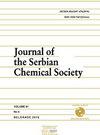Structure and thermal stability of phosphochlorinated polybutadiene/carbon black composite synthesized via oxidative chlorophosphorylation reaction
IF 0.7
4区 化学
Q4 CHEMISTRY, MULTIDISCIPLINARY
引用次数: 0
Abstract
The aim of the presented work was to obtain a new type of homogeneous composite based on an industrial polymer (polybutadiene, PB) and a well-known inexpensive filler (carbon black P-234, CB). For this purpose, the reaction of oxidative chlorophosphorylation (OxCh) was used. This makes it possible to introduce CB into the cross-linked structure of the modified polymer and ensure optimal distribution of the filler in it. The structure and thermal stability of the composite synthesized by the OxCh reaction were studied. Analysis of the composite by Fourier-transform infrared spectroscopy indicates a uniform distribution of carbon black in the network structure of the matrix and the physical interaction of the phases of the composite. Ultraviolet-visible spectrum data confirmed the improvement in light absorption in a wide range of the electromagnetic spectrum and the decrease in the optical band gap energy of the phosphochlorinated PB (PhPB) matrix with the addition of CB (Eg of PhPB=3.25 eV; Eg of PhPB/CB composite=2.28 eV). The influence of CB on the thermal stability of the PhPB matrix was studied using thermogravimetric and differential thermogravimetric analysis. After thermal analysis, the char yield for PhPB was 41 wt%, and for PhPB/CB composite was 35.2 wt%. Compared to PhPB, the increase in char yield, the decrease in maximum thermal decomposition temperature, and the high-integrated thermal decomposition temperature for the PhPB/CB composite show the improvement in the thermal stability of PhPB due to CB.氧化氯化反应合成的聚丁二烯/炭黑复合材料的结构和热稳定性
本文的目的是制备一种新型的均相复合材料,该复合材料是基于工业聚合物(聚丁二烯,PB)和一种众所周知的廉价填料(炭黑P-234, CB)。为此,采用了氧化氯磷酸化(OxCh)反应。这使得将CB引入到改性聚合物的交联结构中并确保填料在其中的最佳分布成为可能。研究了氧化羰基反应合成的复合材料的结构和热稳定性。傅里叶红外光谱分析表明,炭黑在基体的网状结构中分布均匀,复合材料的相之间存在物理相互作用。紫外可见光谱数据证实,加入CB后,磷氯化PB (PhPB)基体在较宽的电磁波谱范围内的光吸收得到改善,光学带隙能降低(PhPB的Eg =3.25 eV;PhPB/CB复合材料Eg =2.28 eV)。采用热重法和差热重法研究了炭黑对PhPB基体热稳定性的影响。经热分析,PhPB炭产率为41 wt%, PhPB/CB复合炭产率为35.2%。与PhPB相比,PhPB/CB复合材料炭产率的提高、最大热分解温度的降低和热分解温度的高积分表明,CB的加入改善了PhPB的热稳定性。
本文章由计算机程序翻译,如有差异,请以英文原文为准。
求助全文
约1分钟内获得全文
求助全文
来源期刊
CiteScore
1.80
自引率
0.00%
发文量
76
审稿时长
1 months
期刊介绍:
The Journal of the Serbian Chemical Society -JSCS (formerly Glasnik Hemijskog društva Beograd) publishes articles original papers that have not been published previously, from the fields of fundamental and applied chemistry:
Theoretical Chemistry, Organic Chemistry, Biochemistry and Biotechnology, Food Chemistry, Technology and Engineering, Inorganic Chemistry, Polymers, Analytical Chemistry, Physical Chemistry, Spectroscopy, Electrochemistry, Thermodynamics, Chemical Engineering, Textile Engineering, Materials, Ceramics, Metallurgy, Geochemistry, Environmental Chemistry, History of and Education in Chemistry.

 求助内容:
求助内容: 应助结果提醒方式:
应助结果提醒方式:


